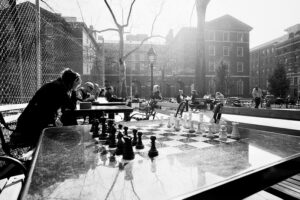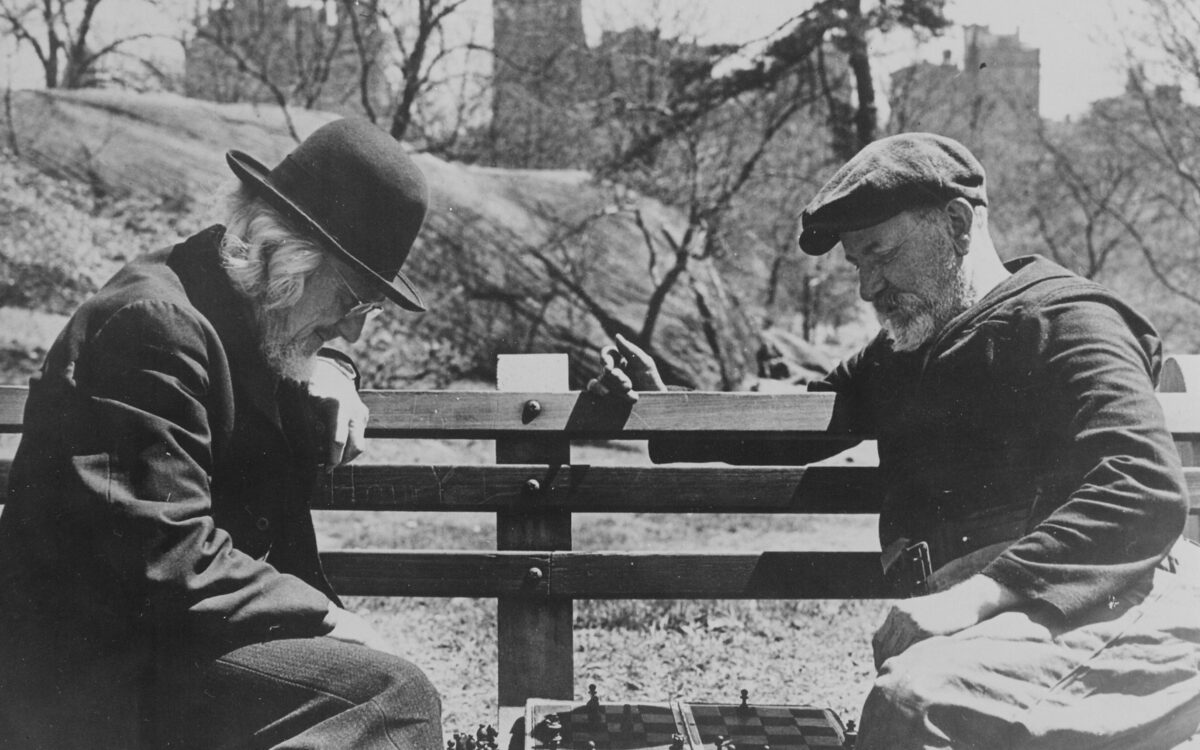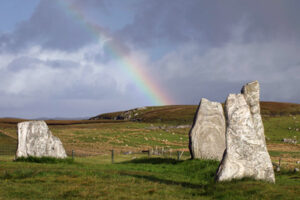The Origin of Chess in Central Park
As we traverse the captivating narrative of chess in Central Park, we journey back to a time when the park was still in its infancy. The tradition of chess playing in the park dates back many decades. Yet, its precise origin remains as elusive as a checkmate in a grandmaster’s game. What we do know is that this practice has been woven into the fabric of Central Park for as long as most can remember.
The chess culture of Central Park owes much to the immigrant communities that have shaped New York City’s diverse heritage. The game of chess, with its roots tracing back to the 6th century in India, gradually spread to the Middle East and Europe before crossing the oceans to America. As people from across the world sought a new life in the bustling metropolis of New York, they brought with them their traditions, their languages, and their love for chess.
Picture this: the year is 1910. Immigrants from Eastern Europe, Italy, and beyond disembark from ships onto Ellis Island, their hearts filled with hope, their suitcases carrying cherished mementos from their homelands. Among these treasured possessions are often simple, well-worn chess boards. As these new New Yorkers start to settle in and find their place in the city’s vibrant tapestry, they naturally seek the company of their fellow compatriots in the welcoming greenery of Central Park. Here, beneath the dappled shade of the park’s towering trees, they lay out their chess sets, and the air becomes charged with the silent tension and intellectual rigor of the game.
Thus, Central Park’s chess tradition was born, nurtured by the city’s diverse inhabitants who found common ground over the chessboard’s checkered expanse. It’s a tradition that continues to thrive today, offering a living testament to the city’s multicultural heritage and the universal appeal of chess.
The Chess & Checkers House

Nestled within the lush foliage of Central Park, near 64th Street, lies a charming pavilion known as the Chess & Checkers House. Built in 1952, this dedicated hub for chess, checkers, and other board games has quietly stood the test of time, inviting countless park-goers to indulge in their love for these intellectually stimulating pastimes.
Constructed from red brick and limestone, the Chess & Checkers House resembles a quaint cottage straight out of a storybook. Twelve game tables grace its spacious terrace, while inside, the warmth of the room invites visitors to delve into a game or simply observe the fascinating dynamics of play.
But the Chess & Checkers House is not just a physical space; it’s a testament to the enduring appeal of chess in Central Park. It serves as a gathering place for board game enthusiasts of all ages and skill levels, providing a communal space for the exchange of ideas, strategies, and friendly competition.
Over the years, the Chess & Checkers House has played a pivotal role in promoting the game of chess, hosting numerous tournaments and casual matches. It offers free game piece rental, encouraging park visitors to engage in a spontaneous game and immerse themselves in this centuries-old tradition. Through these endeavors, the Chess & Checkers House continues to play its part in nurturing Central Park’s rich chess culture and inviting a new generation to participate in this timeless game.
The Vibrant Street Chess Culture

Beyond the confines of the Chess & Checkers House, the chess culture of Central Park spills onto the sidewalks and park benches. The street chess scene, pulsating with energy and camaraderie, is as much a part of Central Park as its iconic greenery. This open-air chess phenomenon brings together a broad spectrum of enthusiasts – from wide-eyed beginners to seasoned pros, each contributing to the lively atmosphere with their unique style of play and personality.
The park’s regular players often set up portable boards, waiting for a passerby eager for a friendly match or even a small wager. These impromptu games, played amidst the hum of park life, encapsulate the spirit of Central Park chess.
The street chess culture in Central Park isn’t just confined to the park; it has permeated popular culture too. The film “Searching for Bobby Fischer” beautifully captures this thriving scene, featuring the park’s stone tables as a backdrop for young prodigy Josh Waitzkin’s chess encounters. This pop culture mention underscores the significance of Central Park’s chess scene as a training ground for budding champions and a symbol of New York City’s love for the game.
Whether it’s the contagious excitement of a nail-biting match, the heartwarming sight of a child learning to move the pawns, or the old-timers spinning tales of legendary games of yesteryears, street chess is the heartbeat of Central Park. It’s a culture that celebrates diversity, intellectual pursuit, and the shared love for a game that transcends age and background. This is the chess culture of Central Park – alive, welcoming, and vibrantly New York.
Celebrity Visits and Famous Games
Central Park’s storied chess tradition has caught the attention of several renowned players over the years. One of the most illustrious names associated with the park’s chess scene is none other than Bobby Fischer, one of the greatest chess players of all time.
As a teenager, Fischer was said to frequent the park’s chess tables, honing his skills in intense matches under the canopy of trees. This was where he might have contemplated the strategies that would eventually lead him to become a World Chess Champion. Fischer’s association with Central Park adds an undeniable layer of mystique to the park’s chess culture, with visitors often speculating which table he favored or what epic games were played there.
Another memorable chapter in Central Park’s chess history is the series of open-air tournaments that have taken place there. One such tournament was the “Central Park Chess Showdown” which brought together amateur and professional players alike in a spirited display of strategy and skill. With hundreds of spectators gathered around, the park was transformed into a grand outdoor chess arena, affirming its status as a beloved hub for chess enthusiasts.
Chess Events and Tournaments

These celebrity visits and significant games have etched Central Park’s chess scene into popular lore, cementing its place in the annals of chess history. The allure of playing a game of chess in the same space where grandmasters once sat is a unique thrill that draws novices and veterans alike to the park’s chess tables. Through these shared experiences, the spirit of these legendary players and games continues to live on in Central Park, inspiring a new generation of chess enthusiasts.
Over the years, Central Park has played host to a myriad of chess events and tournaments, fostering a vibrant chess community that extends beyond the park’s boundaries. These gatherings, large and small, serve as a testament to the enduring popularity of chess in New York City.
One such event is the annual “Central Park Chess Festival,” a day-long celebration of the game that invites players of all ages and skill levels to participate. This festival is more than just a tournament; it’s a celebration of chess culture that includes lessons for beginners, simultaneous exhibitions, speed chess, and of course, the main tournament. The sight of hundreds of chess enthusiasts, gathered under the park’s leafy canopy with chessboards spread out before them, is a sight to behold.
Another noteworthy event is the “Grandmaster Simul,” where a visiting grandmaster takes on multiple opponents simultaneously. This event gives chess enthusiasts a rare opportunity to test their mettle against some of the world’s best players, right in the heart of their city.
These events and tournaments offer more than just a chance for competition; they bring together a diverse community united by their love for chess. They provide a platform for chess lovers to learn from each other, share their passion, and contribute to New York City’s vibrant chess culture.
By regularly hosting these events, Central Park continues to uphold its role as an epicenter of chess in New York City, fostering a welcoming environment where the city’s chess culture can continue to flourish.
The Social Impact of Chess in Central Park
While the game of chess is often perceived as a battle of intellects between two players, its social impact extends far beyond the 64 squares of the chessboard. In the microcosm of Central Park, chess plays a pivotal role in fostering a unique sense of community, one that transcends age, ethnicity, and social backgrounds.
A walk through Central Park’s chess hotspots presents a diverse tableau of New Yorkers and visitors alike. Here, high school students square off against seasoned retirees, investment bankers play against street performers, and chess enthusiasts of all nationalities come together for the love of the game. The common language they speak is chess – each move, each gambit, and each checkmate serving to connect them in this shared pursuit.
This unifying aspect of chess is a cornerstone of Central Park’s vibrant social fabric. The game doesn’t just pit one player against another; it encourages dialogue, fosters mutual respect, and creates an environment of learning and sharing. Regular players become familiar faces, opponents become friends, and seasoned players become mentors to the novices.
The societal benefits of this are profound. The game instills values of patience, strategic thinking, and respect for the opponent. For younger players, these interactions serve as lessons not just in chess, but in life.

In an era where digital interactions often supersede face-to-face connections, the chess scene in Central Park stands as a heartening exception. It celebrates the simple joy of gathering around a chessboard, embarking on a cerebral adventure, and connecting with others in a meaningful way.
This is the social impact of chess in Central Park – a thriving, welcoming community that encapsulates the spirit of the game and the city itself. Through chess, Central Park continues to play its part in bridging gaps, promoting inclusivity, and nurturing a diverse community bound by a shared passion.
As we’ve journeyed through the captivating narrative of chess in Central Park, we’ve unearthed a rich tapestry of history, culture, and community that continues to thrive today. From its humble beginnings as an immigrant pastime, chess in Central Park has evolved into a vibrant tradition that is as integral to the park’s identity as its scenic landscapes.
We’ve explored the charming Chess & Checkers House, a testament to the enduring popularity of chess, and delved into the lively world of street chess that imbues the park with a unique energy. We’ve walked in the footsteps of legends like Bobby Fischer, revisited famous games, and felt the pulse of numerous chess events and tournaments that continue to foster a thriving chess community in the heart of New York City.
The enduring allure of chess in Central Park is a testament to the universal appeal of this timeless game. It’s a reminder that despite our varied backgrounds and walks of life, we can find common ground over a game of chess. As we engage in this centuries-old tradition, we aren’t just playing a game; we’re part of a vibrant community, continuing a cherished tradition, and perhaps, inspiring a future grandmaster who makes their first move in Central Park.
Whether you’re a seasoned player, a casual enthusiast, or simply an observer, the chess culture of Central Park invites you to be a part of its ongoing story. In the symphony of the city that never sleeps, the click-clack of chess pieces moving across the board is a persistent beat – a testament to a tradition that continues to thrive, right in the heart of New York City.




